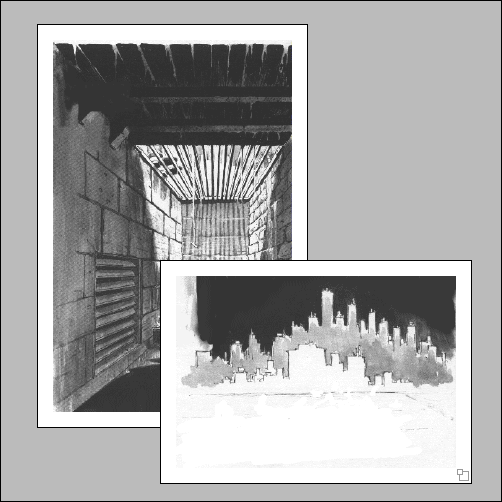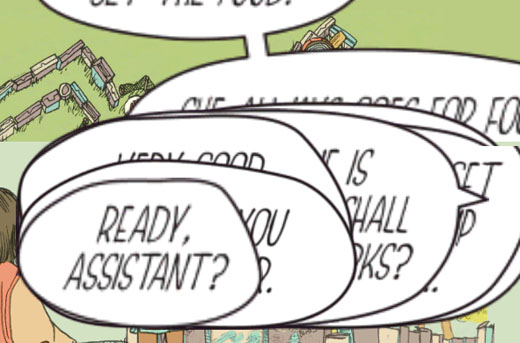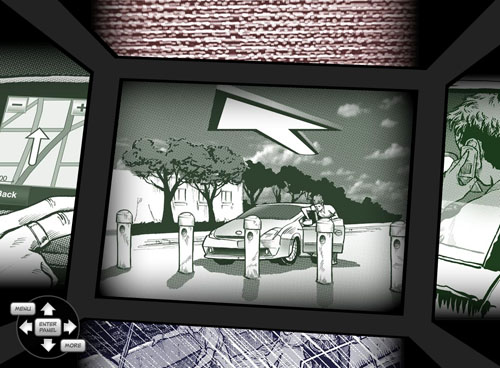The prototype that led to Upgrade Soul
Comics, Experiments, Opertoon,
10/31/12
To celebrate the launch of Upgrade Soul, here’s a screen shot of an eleven year old prototype I made that sets artwork from Will Eisner’s “The Treasure of Avenue ‘C’” (a story from New York: The Big City) in two dynamically resizable panels. At the time I was deep in production on Chroma, but my head was also ringing with inspiration from Scott McCloud’s Understanding Comics, and emboldened by a generous conversation with the man himself (who had been recently asked to comment by a New York Times reporter on whether Chroma was a graphic novel. The verdict? No, and rightly so).
It struck me that it would be pretty cool to make a comic with panels that could be resized, so I scanned in Eisner’s work and put this test together (complete with little window resizing icons in the lower-right corners to grab on to). Digital comics have been a passion for me ever since.

waiting in the wings
Authoring Tools, Comics, Opertoon,
2/3/12

Dialogue bubbles huddle together in the Unity authoring environment like backstage theatre performers awaiting their chance to shine in the forthcoming iOS and Android release Upgrade Soul, from Opertoon.
Precision Targets launches; interactive comic and essay within a navigable cube
Animation, Announcements, Comics, Digital Humanities, Flash, Flex,
4/30/10
It’s been a long time in coming, but I’m very happy to announce the official launch of Precision Targets, a collaboration with scholar Caren Kaplan that uses a hybrid comic/essay format to explore the militarization of everyday life through technologies like GPS. Precision Targets places the user inside a cube containing six parallel stories told through interactive comic panels that are married to threads of commentary by Kaplan.
Precision Targets was my first collaboration with illustrator Ezra Claytan Daniels, and my first experiment with digital comics. Each story consists of four panels which can be browsed by rotating a cube. Individual panels (some of which contain animation and interactivity) can be entered and navigated with the mouse. Every panel has associated commentary by Kaplan which can be expanded by clicking “more”. Clicking “more” again further expands the commentary to a full-screen view for more in-depth reading, making it possible for users to switch between visual, textual, or hybrid reading modes at will. (Be sure to try adjusting the window size; the piece will adapt to whatever aspect ratio you like.)
One element of the project that can be easily missed is the Index, a force-directed SpringGraph visualization of the image and textual elements that make up the piece (you can access this feature by clicking “Menu” and then “Index”). You’ll see the individual graphic elements that make up each panel linked together in an interactive network diagram—to my knowledge, the first time a visualization like this has been applied to the individual layers of comic book panels (feel free to correct me if I’m in error).
This project was conceived before the current “motion comics” trend, so I’m very curious what people will think of the approach, which takes a different tack than most works labeled as such.
Recent Posts
Go InSight: Composing a Musical Summation of Every Mission to Mars (Part 2)
Making music out of the data of interplanetary exploration.
Go InSight: Composing a musical summation of every mission to Mars (Part 1)
Making music out of the data of interplanetary exploration.
Cited Works from “Storytelling in the Age of Divided Screens”
Here’s a list of links to works cited in my recent talk “Storytelling in the Age of Divided Screens” at Gallaudet University.
Timeframing: The Art of Comics on Screens
I’m very happy to announce the launch of “Timeframing: The Art of Comics on Screens,” a new website that explores what comics have to teach us about creative communication in the age of screen media.
The prototype that led to Upgrade Soul
To celebrate the launch of Upgrade Soul, here’s a screen shot of an eleven year old prototype I made that sets artwork from Will Eisner’s “The Treasure of Avenue ‘C’” (a story from New York: The Big City) in two dynamically resizable panels.
Categories
Algorithms
Animation
Announcements
Authoring Tools
Comics
Digital Humanities
Electronic Literature
Events
Experiments
Exemplary Work
Flash
Flex
Fun
Games
Graphic Design
Interactive Design
iPhone
jQuery
LA Flash
Miscellaneous
Music
Opertoon
Remembrances
Source Code
Typography
User Experience
Viewfinder
Wii
Archives
July 2018
May 2018
February 2015
October 2014
October 2012
February 2012
January 2012
January 2011
April 2010
March 2010
October 2009
February 2009
January 2009
December 2008
September 2008
July 2008
June 2008
April 2008
March 2008
February 2008
January 2008
November 2007
October 2007
September 2007
August 2007
July 2007
June 2007
